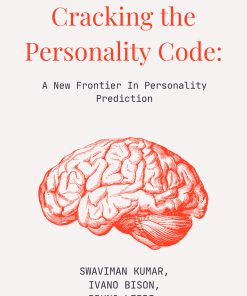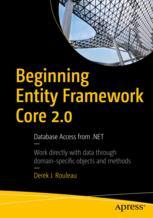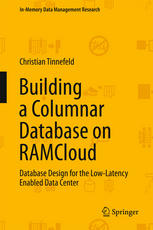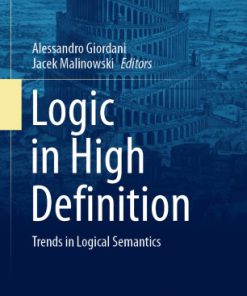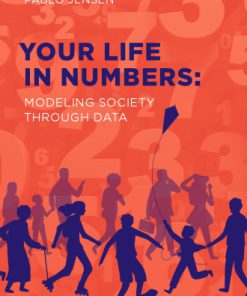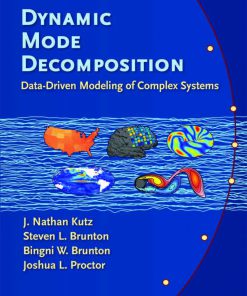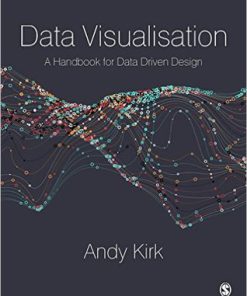Usage Driven Database Design 1st edition by George Tillmann 9781484227213 1484227212
$50.00 Original price was: $50.00.$25.00Current price is: $25.00.
Usage Driven Database Design 1st edition by George Tillmann – Ebook PDF Instant Download/Delivery:9781484227213,1484227212
Full dowload Usage Driven Database Design 1st edition after payment

Product details:
ISBN 10:1484227212
ISBN 13:9781484227213
Author:George Tillmann
Design great databases―from logical data modeling through physical schema definition. You will learn a framework that finally cracks the problem of merging data and process models into a meaningful and unified design that accounts for how data is actually used in production systems.
Key to the framework is a method for taking the logical data model that is a static look at the definition of the data, and merging that static look with the process models describing how the data will be used in actual practice once a given system is implemented. The approach solves the disconnect between the static definition of data in the logical data model and the dynamic flow of the data in the logical process models.
The design framework in this book can be used to create operational databases for transaction processing systems, or for data warehouses in support of decision support systems. The information manager can be a flat file, Oracle Database, IMS, NoSQL, Cassandra, Hadoop, or any other DBMS.
Usage-Driven Database Design emphasizes practical aspects of design, and speaks to what works, what doesn’t work, and what to avoid at all costs. Included in the book are lessons learned by the author over his 30+ years in the corporate trenches. Everything in the book is grounded on good theory, yet demonstrates a professional and pragmatic approach to design that can come only from decades of experience.
- Presents an end-to-end framework from logical data modeling through physical schema definition.
- Includes lessons learned, techniques, and tricks that can turn a database disaster into a success.
- Applies to all types of database management systems, including NoSQL such as Cassandra and Hadoop, and mainstream SQL databases such as Oracle and SQL Server
What You’ll Learn
- Create logical data models that accurately reflect the real world of the user
- Create usage scenarios reflecting how applications will use a new database
- Merge static data models with dynamic process models to create resilient yet flexible database designs
- Support application requirements by creating responsive database schemas in any database architecture
- Cope with big data and unstructured data for transaction processing and decision support systems
- Recognize when relational approaches won’t work, and when to turn toward NoSQL solutions such as Cassandra or Hadoop
Usage Driven Database Design 1st Table of contents:
Part I: Introduction
Chapter 1: Introduction to Usage-Driven Database Design
Database Design Principle 1: Separation Principle
Database Design Principle 2: Distinction Principle
The Difference Between Separation and Distinction
Database Design Principle 3: Convergence Principle
The Separation, Distinction, and Convergence Principles
Database Design Principle 4: Minimal Regression Principle
Usage-Driven Database Design
Logical Data Modeling
Physical Schema Definition
The Terminology Trap
Notes
Part II: Logical Data Modeling
Chapter 2: The E-R Approach
A Little Data Modeling History
Some Important Definitions
Logical Data Modeling Objects
Entities
Type-Instance Distinction
Relationships
Attributes
Notes
Chapter 3: More About the E-R Approach
More About Relationships
Membership Class
Cardinality
Modality
Degree
Binary Relationship
N-ary Relationships
Unary or Recursive Relationships
Relationship Constraints
Inclusion
Exclusion
Conjunction
Simple Conjunction
Conditional Conjunction
Recursive Modality Constraints
More About Entities
Attributive Entity
Associative Entities
Supertype and Subtype Entities (Generalization and Specialization)
More About Attributes
Attribute Domain
Attribute Source: Primitive and Derived
Attribute Descriptor and Unique Identifier
Compound or Concatenated Unique Identifiers
Attribute Complexity: Simple and Group
Attribute Valuation: Single Value and Multivalue
Attribute Complexity and Valuation
Chapter 4: Building the Logical Data Model
The Interview Process
Gather Information and Review
1. Identify the Users Who Are Authorities or Experts on the Subject
2. Meet and Interview the Experts and Identify the Subject (Application) Entities
Preparation
The First Interview
3. Identify Relationships Between the Entities
4. Identify the Properties or Attributes of the Entities and Relationships
Analyze Information
Construct Model
Repeat as Necessary
Making Sense of the Interview
Modeling Rules
Verifying What You Have Heard
Immediate Interview Feedback
Formal Walk-Throughs
Increasing E-R Diagram Comprehension
Subject Areas
Entity Fragments
Neighborhood Diagrams
Relationship Bridges and Stubs
Some Model Building Best Practices
Getting Started
Don’t Lose Control of the Project to Users
Don’t Lose Control of the Project to Technical Staff
Don’t Become Dependent on Tools or Techniques
Don’t Get Bogged Down in Endless Analysis
The Players…and the Rules of Engagement
Deliverables
Examples of Deliverables
Sample Data Dictionary, Data Object Definitions
Notes
Chapter 5: LDM Best Practices
Abbreviations
Almost Unique Identifiers
Clarity
Compound Unique Identifiers
Conceptual Integrity
Conjunctive Relationships
Duplicate Super-Subtypes “Type” Data
Exclusive and Nonexclusive Generalization
Required and Nonrequired Participation
Exclusive Relationships
Group Attributes
Level of Abstraction
Many-to-Many Relationships
N-ary Relationships
N-ary Relationships and Membership Class
Naming Objects
Multiple Names
Naming Conventions
Name Uniqueness
Naming Convention Goals
Null Attributes
There Be Blanks in Them Thar Nulls
Optional Relationships (Optional-Optional Relationships)
Subject Areas
Supertypes and Subtypes
Unique Identifiers
Note
Chapter 6: LDM Pitfalls
Circular Relationships
Data Values
Data Value–Differentiated Entities and Attributes
Derived Data
Three Poor Arguments Against Modeling Derived Data
Derived Data as Process
Derived Data and Physical Database Design
Discrete Attributes
Embedded Attributes
Uniqueness
Group Attributes
The Problem with Embedded Attributes
The Solution
The Moral of the Story
Entity Fragmentation
Foreign Keys
Junction Entities
Normalization
Presentation Data
Primary Keys
Process Data
Repeating Groups
Multivalue Attribute
Group Attribute
Single-Attribute Entities
Code
Multivalue Attribute (Repeating Group)
Associative Entities
Substitution Data
Substitution Tables
Transient Data
Location-Dependent Data
Chapter 7: LDM Perils to Watch For
Associatives Related to Other Associatives
Diagrammable Objects
Disassociated Entity Clusters (“Islands”)
Duplicate Unique Identifiers
One Entity, Two or More Identifiers
One Identifier, Two or More Entities
Multiple Relationships
One Relationship, Multiple Views
Multiple Different but Similar Relationships
One-of-a-Kind (OOAK) Entities
One-to-One Relationships
Rare Entity Relationships
Recursive Modality Constraints
Updating the Constraints
Spiderwebs
Too Many Blanks or Nulls
Too Many Recursives
Next U3D Phase: Physical Schema Definition
Notes
Part III: Physical Schema Definition
Chapter 8: Introduction to Physical Database Design
A Short Incondite History of Automated Information Management (or, a Sequential Look at Random Acces
Information Management Era 1: Sequential Processing
Information Management Era 2: The First Random Access DBMS
A Small Digression: A Couple of Words About Database Access
Hashing
Inverted Indices
Database Pages
B-Trees
Bitmaps
Associative Arrays
Information Management Era 3: Inverted File Systems
Information Management Era 4: The Age of Relational
Problems with Relational
First—Performance Issues
Second—Not So Simple Simplicity
Data Types
Procedural Code
Groups
Third—Communication and Language
Fourth—Relational: Theory or DBMS?
Fifth—Where Are You Relational Model?
Just Because It Has Failings Doesn’t Mean It’s a Failure
Information Management Era 5: Object Technology
Object-Oriented Programming Led to Object-Oriented Analysis and Design, Which Eventually Led to the
A Small Digression (Again): The ACID Test
Information Management Era 6: NoSQL
Key-Value
Graph
Document Management
Multimodal
Is That an ACID or a BASE?
And the Winner Is…
What’s to Come
References
Notes
Chapter 9: Introduction to Physical Schema Definition
Usage-Driven Database Design: Physical Schema Definition
Step 1: Transformation
Task 1.1: Translation
Task 1.2: Expansion
Step 2: Utilization
Task 2.1: Usage Analysis
Task 2.2: Path Rationalization
Step 3: Formalization
Task 3.1: Environment Designation
Task 3.2: Constraint Compliance
Step 4: Customization
Task 4.1: Resource Analysis
Task 4.2: Performance Enhancement
Summary
Chapter 10: Transformation: Creating the Physical Data Model
Task 1.1: Translation
Activity 1.1.1: Transform LDM Objects to PDM Objects
Entities to Record Types
Relationships to Linkages
Linkage Membership Class
Linkage Degree
Linkage Constraints
Attributes to Data Items
Data Item Domain
Data Item Source: Primitive and Derived
Primitive Data Item: Unique Identifiers and Descriptors
Data Item Complexity: Simple and Group
Data Item Valuation: Single Value and Multivalue
Other Data Item Information
Activity 1.1.2: Diagram the Objects
Task 1.2: Expansion
Activity 1.2.1: Assign Keys
Activity 1.2.2: Normalize the Model
Adjustments Needed for Normalization: Keys—Foreign and Domestic?
Zero Normal Form
First Normal Form
Before Getting to Second Normal Form, a Slight Digression
Second Normal Form
Third Normal Form
Post-Normalization—Retreat of Sally Forth?
Issues with Normalization
Tranformation Notes
Deliverables
Examples of Deliverables
Chapter 11: Utilization: Merging Data and Process
Task 2.1: Usage Analysis
Process Modeling
Logical Process Modeling
Natural-Language Logical Process Modeling Techniques
Plain English
Oy Vey, There Has Got to Be a Better English Translation
Structured English
Graphical Logical Process Modeling Techniques
Physical Process Modeling
Natural-Language Physical Process Modeling Techniques
Plain English
Structured English
Pseudocode
Graphic Physical Process Modeling Techniques
Flow Charts
Structure Charts
Activity 2.1.1: Create Usage Scenarios
Clearing the Decks for Action
Putting a Usage Scenario Together
An Example
Activity 2.1.2: Map Usage Scenarios to the PDM
Task 2.2: Path Rationalization
Activity 2.2.1: Reduce to Simplest Paths
Activity 2.2.2: Simplify Model
Utilization Notes
Deliverables
Example of Deliverables
Further Reading
Structured English
Data Flow Diagramming
Flow Charts
Pseudocode
Structure Charts
Chapter 12: Formalization: Creating a Schema
Task 3.1: Environment Designation
Hierarchical Systems
Network Systems
Relational Systems
Object-Oriented
NoSQL
DBMS Product and Version Selection
Task 3.2: Constraint Compliance
Pseudocode…Again
Activity 3.2.1: Map Rationalized Physical Data Model to the Data Architecture
Record Types
Proper
Associative
Attributive
S-Type
Links
Membership Class: Cardinality
One-to-One
One-to-Many
Many-to-Many
Membership Class: Modality
Mandatory
Optional
Degree
Unary
Binary
N-ary
Constraints
Inclusion
Exclusion
Conjunction
Data Items
Domains
Source: Primitive and Derived
Primitive Data Items
Derived Data Items
Complexity: Simple and Group
Valuation: Single Value and Multivalue
Activity 3.2.2: Create a DBMS Product/Version-Specific Functional Physical Database Design
Subschema Creation
Formalization Notes
Deliverables
Example of Deliverables
Chapter 13: Customization: Enhancing Performance
Task 4.1: Resource Analysis
The Trade-Off Triangle
Task 4.2: Performance Enhancements
Activity 4.2.1: Customize Hardware
A Few Words About Secondary Storage
Add Disk
Faster Disk
Main Memory
Activity 4.2.2: Customize Software
Indices (B-Tree, Hash, Bitmap)
Clustering
Example Using Indices and Clusters
Question 1: Should Order Be Indexed?
Question 2: Should Product Be Indexed?
Question 3: Should Line Item Be Indexed?
Question 4: Should Line Item Be Clustered?
Question 5: Should Line Item Be Clustered Around Order or Product?
Alternative 1: Line Item Clustered Around Order
Alternative Two: Line Item Clustered Around Product
Partitioning
Derived and Duplicate Data
Denormalization
Get Rid of ACID
Big Data, Big Problems, Big Solution
To Plunge or Not to Plunge
NoSQL
Modeling Big Data U3D Style
Customization Notes
Deliverables
Examples of Deliverables
Chapter 14: The Data Warehouse
The Data Warehouse
Data Warehouse Architecture
Using U3D to Develop a Data Warehouse
Step 1: Transformation
Step 2: Utilization
The Time Dimension
Step 3: Formalization
Step 4: Customization
Streamlining
Duplication
Denormalization
Indices and Hashing
Bitmaps
Bulk Loading
Clustering
Partitioning
Distributed Processing
All Together Now…
Oops…
Customization Notes
Note
Chapter 15: The Big Data Decision Support System
Structured, Unstructured, and Semistructured Data—Another Small Digression
DSS and Big Data
Using U3D to Develop a Big Data Decision Support System
Step 1: Transformation
Step 2: Utililization
Step 3: Formalization
Step 4: Customization
A Little About Hadoop
Putting It All Together
Deliverables
Part IV: Where from Here?
Chapter 16: A Look Ahead
We Need to Ask the Awkward Questions
Tools Need to Take Usage into Account
The One and Only DBMS
Better Training
Notes
Part V: Appendixes
Appendix A: Glossary
Appendix B: Logical Data Modeling Definitions
Entity
Relationship
Attribute
Domain
Appendix C: Physical Schema Definition Object Definitions
Record
Linkage
Data Item
Domain
Cluster
Partition
People also search for Usage Driven Database Design 1st:
what is database design with example
is data driven hyphenated
what is database design
database-driven web applications
c database programming
Tags:
George Tillmann,Usage,Database,Design
You may also like…
Politics & Philosophy - Social Sciences
Data Visualisation: A Handbook For Data Driven Design Andy Kirk
Mathematics - Probability
Analyzing Data through Probabilistic Modeling in Statistics 1st Edition Dariusz Jakóbczak
Psychology - Social Psychology
Computers - Hardware
Politics & Philosophy
Logic in High Definition: Trends in Logical Semantics Alessandro Giordani
Mathematics - Applied Mathematics
Dynamic Mode Decomposition Data Driven Modeling of Complex Systems 1st Edition J. Nathan Kutz
Computers - Databases






